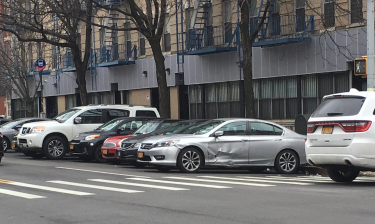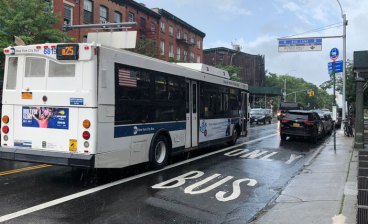NYC’s Car-Free Majority Deserves a Share of Defunct Bus Stops
 Photo: cyclosity/Flickr
Photo: cyclosity/Flickr When the MTA service cuts took effect last month, 570 bus stops around the city suddenly became a collective no-man’s land. Buses weren’t pulling up to the curb anymore, creating an irresistible vacuum for motorists. If you belong to a neighborhood message board or listserve, you may have come across a few dispatches from car owners salivating over the prospect of more parking.
Maybe it’s impolitic to discuss how to use this space while the pain of the service cuts still stings, but the NYPD isn’t waiting to manage all that real estate: They’ve stopped ticketing motorists for parking in the bus stops. Acres of space that used to accommodate transit riders are now de facto parking spots.
We reported in May that this is mostly what the city has in mind anyway. DOT’s plan is to turn most bus stops into parking spaces, or convert them to loading zones where deemed necessary. At a meeting of Brooklyn Community Board 6 last night, a DOT
representative reiterated the department’s intention to primarily use
the bus stops for storing private vehicles. He also expressed some
openness to installing bike parking in the bus shelters, but not on the
street itself.
While the loading zones will help reduce double-parking, it looks like we’re still on track for a significant redistribution of public space that won’t benefit the 55.7 percent of New York households which don’t own a car.
It doesn’t have to end up this way. In San Francisco, the city took some highly visible steps to convert defunct bus stops to non-automotive uses. Some bus stops were re-purposed as bike corrals, with secure parking for six to twelve bikes at each stop. Elsewhere, they used the free space to shuffle around the street’s parking spaces and install a "parklet," a temporary public plaza built along the curb.
This is an important time to act on the idea, exemplified by Summer Streets, that streets form the bulk of the city’s public space and belong to everyone. Here are a few treatments that would make life better for New York’s car-free majority:
- At dangerous intersections, shift the parking spaces around so that the pedestrian crossings are daylighted, allowing drivers and peds to see each other better
- If a BID or other group can maintain the space, set it off with planters and add some seating
- On streets with lots of foot traffic, designate official zones for food vendors
- We said it before but it just makes so much sense: bike corrals
DOT has figured out how to do some pretty ingenious things with newly available curbside space, and really, the only equitable way to divide up these stops would be to devote most of them to car-free uses. New Yorkers who don’t own cars shouldn’t be shut out of using our old bus stops.


